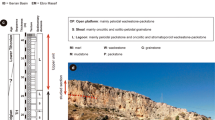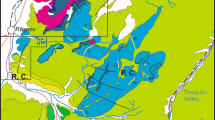Abstract
The microfauna of the upper member of the Láncara Formation in the Somiedo-Correcilla unit (Lower-Middle Cambrian, Cantabrian zone, northwestern Spain) is described in detail and discussed in respect to biofacies and palaeoecology. The study of about 140 thin sections allows to reconstruct a sediment-tological model based on bio- and lithofacial trends. A vertical faunal differentiation is detected in the three studied outcrops. The base of the upper member of the Láncara Formation (Beleño facies) is characterised by a high amount of sessile suspension feeders (echinoderms) which indicate a low or absent siliciclastic influx. The amount of trilobites (mobile deposit feeders) and sessile filter feeders (brachiopods) is clearly lower. This echinoderm-rich facies characterises the lower few meters and is called Faunal Assemblage A. The transition to Fauanl Assemblage B is characterised by a decrease of sessile suspension feeders, whereas the mobile organisms increase in percentage. This evolution continues in Fauanl Assemblage C, which is dominated by mobile suspension-and sessile filter-feeders. The continuous lithological and faunal succession, but overall low faunal and facial gradients of the upper member of the Láncara Formation are representative for a ramp environment. The deposition is interpreted as a turnover from an east-tilted homoclinal carbonate ramp (lower member of the Láncara Formation) to a mixed carbonate-siliciclastic ramp (Beleño and Barrios facies, respectively Fauanl Assemblages A, B, C, D). The abrupt appearance of the Fauanl Assemblage A points to a sudden subsidence of the environment. A continuous increase in the siliciclastic content is accompanied with a successive change in the faunal composition from a fauna dominated by sessil suspension feeders to a mobile deposit feeder-dominated one. The increase of siliciclastic material indicates a more or less constant rise of sealevel that caused an onshore shift of the facies belts, and mirrors the general drowning of the ramp.
Similar content being viewed by others
References
Álvaro, J.J. and Vennin, E., 1996, Tectonic control on Cambrian sedimentation in South-Western Europe. Ecologae Geologicae Helvetiae, 89, 935–948.
Álvaro, J.J. and Vennin, E., 1997, Episodic development of Cambrian eocrinoid-sponge meadows in the Iberian Chains (NE Spain). Facies, 37, 49–64.
Álvaro, J.J., Vizcaino, D. and Vennin, E., 1999, Trilobite diversity patterns in the Middle Cambrian of southwestern Europe a comparative study. Palaeogeography, Palaeoclimatology, Palaeoecology, 151, 241–254.
Álvaro, J.J., Vennin, E., Moreno-Eiris, E., Perejón, A. and Bechstädt, T., 2000, Sedimentary patterns across the Lower-Middle Cambrian transition in the Esla nappe (Cantabrian Mountains, northern Spain). Sedimentary Geology, 137, 43–61.
Álvaro, J.J., Van Vliet-Lanoë, B., Vennin, E. and Blanc-Valleron, M.-M., 2003, Lower Cambrian paleosols from the Cantabrian Mountains (northern Spain): a comparison with Neogene-Quarternary estuarine analogues. Sedimentary Geology, 163, 67–84.
Aramburu, C. and Garcia-Ramos, J.C., 1993, La sedimentación cambro-ordovícica en la Zona Cantábrica (NO de España). Trabajos de Geologia, 19, 45–73.
Aramburu, C., Truyols, J., Arbizu, M., Méndez-Bedia, I., Zamarreño, I., García-Ramos, J.C., Suarez de Centi, C. and Valenzuela, 1992. El Paleozoico Inferior de la Zona Cantábrica. In: Gutiérrez Marco, J.C., Saavedra, J. and Rábano, I. (eds.), Paleozoico Inferior de Ibero-América, Madrid, p. 397–421.
Bechstädt, T. and Boni, M., 1989, Tectonic control on the formation of a carbonate platform: the Cambrian of southwestern Sardinia. The Society of Economic Paleontologists and Mineralogists, Special Publication, 44, 107–122.
Bechstädt, T. and Boni, M., eds., 1994, Sedimentological, stratigraphical and ore deposits field guide of the autochthonous, Cambro-Ordovician of southwestern Sardinia. Memorie descrittive della carta geologica d'Italia, vol. XLVIII. Servizio Geologico Nazionale, 434 p.
Bechstädt, T., Schledding, T. and Selg, M., 1988, Rise and fall of an isolated, unstable carbonate platform: the Cambrian of South-western Sardinia. Geologische Rundschau, 77, 389–416.
Cocozza, T. and Gandin, A., 1990, Carbonate deposition during early rifting: the Cambrian of Sardinia and the Triassic-Jurassic of Tuscany, Italy. Special Publication of the International Association of Sedimentologists, 9, 9–37.
Crimes, T.P., Legg, I., Marcos, A. and Arboleya, M.L., 1977, Late Precambrian-low Lower Cambrian trace fossils from Spain. In: Crimes, T.P. and Harper, J.E. (eds.), Trace Fossils. Geological Journal, Special Publication, 9, p. 91–138.
Fernández Remolar, D.C., 2001, Chancelloridae del Overtiense Inferior de la Sierra de Córdoba, España. Revista Española de Paleontologia, 16, 39–62.
Geyer, G., 1986, Mittelkambrische Mollusken aus Marokko und Spanien. Senckenbergiana lethaea, 67, 55–118.
Julivert, M., 1971, Décollement tectonics in the Hercynian Cordillera of NW Spain. American Journal of Science, 270, 1–29.
Lotze, F., 1945, Zur Gliederung der Varisciden der Iberischen Meseta. Geotektonische Forschungen, 6, 63–81.
Liñán, E., Gozalo, R., Palacios, T., Gámez Vintaned, J.A., Ugidos, J.M. and Mayoral, E., 2002, Cambrian. In: Gibbson, W. and Moreno, T. (eds.), The Geology of Spain. Geological Society, London, p. 17–31.
Lotze, F., 1961, Das Kambrium Spaniens. Teil I: Stratigraphie. Akademie der Wissenschaften und der Literatur, Mainz, Abhandlungen der mathematisch-naturwissenschaftlichen Klasse, 1–216.
Martin Parra, L.M., 1989, Mapa Geológico de España, 2a serie, no. 128 (Riello) (1∶50,000). ITGE Press Madrid, p. 1–119.
Palacios, T. and Vidal, G., 1992, Lower Cambrian acritarchs from Northern Spain: the Precambrian-Cambrian boundary and biostratigraphic implications. Geological Magazine, 129, 421–436.
Parga, J.R. and Luque, C., 1971, Las series del Cámbrico y Eocámbrico en la Cordillera Cantábrica. Boletin Geologico y Minero, 82, 310–320.
Pérez-Estaún, A., Bastida, F., Alonso, J.L., Marquinez, J., Aller, J., Alvarez-Marrón, J., Marcos, A. and Pulgar, J.A., 1988, A thinskinned tectonics model for an arcuate fold and thrust belt: the Cantabrian Zone (Variscan Ibero-Armorican Arc). Tectonics, 7, 517–537.
Rodrignes Fernández, L.R., Barba, P., Bardaji, T., Silva, P.G., Suárez Rodriguez, P.I., Heredia, N., Gallastegui, G., Paniagua, A. and Galán, L., 1991, Mapa Geológico de España, 2a serie, no. 102 (Los Barrios de Luna) (1∶50,000). ITGE Press, Madrid, p. 1–130.
Rupke, J., 1965, The Esla nappe, Cantabrian Mountains (Spain). Leidse Geologische Mededelingen, 32, 1–74.
Russo, A. and Bechstädt, T., 1994, Evolución sedimentológica y paleogeográfica de la Formación Vegadeo (Cámbrico inferiormedio) en la zona entre Visuña y Piedrafita do Caurel (Lugo, NO de España). Revista de la Sociedad Geológica de España, 7, 299–310.
Sdzuy, K., 1961, Das Kambrium Spaniens. Teil III: Trilobiten Akademie der Wissenschaften und der Literatur, Abhandlungen der mathematisch-naturwissenschaftlichen Klasse, p. 217–408.
Sdzuy, K., 1969, Unter-und mittelkambrische Porifera (Chancelloriida und Hexactinellida). Paläontologische Zeitschrift, 43, 115–147.
Sdzuy, K., 1974, Mittelkambrische Graptolithen aus NW-Spanien. Paläontologische Zeitschrift, 48, 110–139.
Seilacher, A., 1970, Cruziana stratigraphy of ‘non fossiliferous’ Palaeozoic sandstones. In: Crimes, T.P. and Harper, J.E. (eds.), Trace Fossils. Geological Journal, Special Publication, 3, p. 444–476.
Truyols, J., Arbizu, M.A., Garcia Alcalde, J.L., Garcia López, S., Méndez Bedia, I., Soto, F. and Truyols Massoni, M., 1990, Cantabrian and Palentian Zones; Stratigraphy: The Asturian-Leonese Domain (Cantabrian Zone). In: Dallmeyer, R.D. and Martinez Garcia, E. (eds.), Pre-Mesozoic Geology of Iberia. Springer Verlag, Berlin, p. 10–19.
Van den Bosch, W.J., 1969, Geology of the Luna-Sill region, Cantabrian Mountains (NW Spain). Leidse Geologische Mededelingen, 44, 137–225.
Van den Boogaard, M., 1983, The occurrence ofHadimopanella oezgueli Gedik in the Láncara Formation in NW Spain. Palaeontology, 86, 331–341.
Van der Meer Mohr, C.G., 1983, The Lower Palaeozoic of the Leonides and Pisuerga-Carrión Province in the Cantabrian zone of northwest Spain. ITC Journal, 3, 205–213.
Van Staalduinen, C.J., 1973, Geology of the area between the Luna and Torio rivers, southern Cantabrian Mountains. NW Spain Leidse Geologische Mededelingen, 49, 167–205.
Vidal, G., Palacios, T., Moczydowska, M. and Gubanov, A.P., 1999, Age constraints from small shelly fossils on the early Cambrian terminal Cadomian Phase in Iberia. Geologiska Föremingens Forhandlingar, 121, 137–143.
Wotte, Th., Elicki, O., Perejón, A. and Moreno-Eins, E., 2004, Facies distribution patterns and environment interpretation of the Upper Láncara Formation in the Esla Nappe (Cantabrian zone, NW Spain) by quantitative microfacies analysis. Freiberger Forschungshefte, C 502. Paläontologie, Stratigraphie, Fazies, 12, 101–118.
Zamarreño, I., 1972, Las litofacies carbonatadas del Cámbrico de la Zona Cantábrica (NW de España) y su distribución paleogeográfica. Trabajos de Geologia, 5, 1–118.
Zamarreño, I., 1975, Peritidal origin of Cambrian carbonates in Northwest Spain. In: Ginsburg, R.N. (ed.), Tidal Deposits: a Case Book of Recent Examples and Fossil Counterparts. Springer Verlag, Berlin, p. 323–332.
Author information
Authors and Affiliations
Rights and permissions
About this article
Cite this article
Wotte, T. Facies distribution patterns and environment reconstruction of the upper member of the Láncara Formation in the Somiedo-Correcilla unit (Lower-Middle Cambrian, Cantabrian zone, NW Spain) with special respect to biofacial investigations. Geosci J 9, 173–186 (2005). https://doi.org/10.1007/BF02910578
Received:
Accepted:
Issue Date:
DOI: https://doi.org/10.1007/BF02910578




